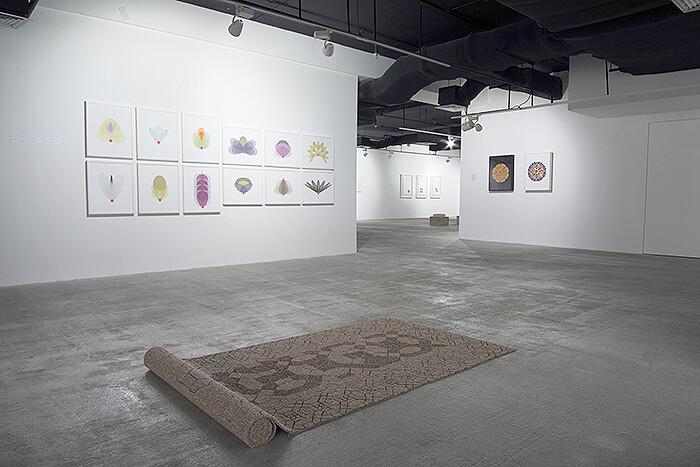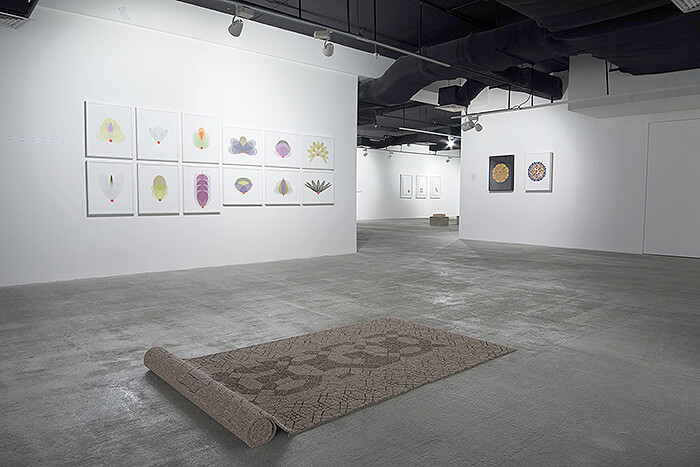July 10–October 10, 2014
Everything Would Appear To Man, As It Is, Infinite. The title and subscript from Michael John Whelan’s framed print on the second floor of Athr’s 1500-square-meter gallery space in Jeddah encapsulates the ambitious group show “The Language of Human Consciousness.” The exhibition—curated by collector and Athr’s co-founder Mohammed Hafiz, closely assisted by Jumana Ghouth—was planned to launch during the holy month of Ramadan this summer. Coyly sidestepping the figurative (frowned upon in conservative Islam), the exhibition takes a surveying stab at the vast world of geometry in art, from the sacred to the profane, featuring an eclectic range of works.
The exhibition oscillates between the mystical and the crude, the minimal and the decorative, the currency of symbols, geometrically speaking, and the prime (symbolic) value of exhibition making in a city that is, in terms of art institutions, emerging. It follows a metronomic order of display, giving off a serene yet homogenous feel. As one approaches individual works more closely, associations and pairings draw imaginary lines that crisscross the abounding void between the art-lined walls of immaculately white and concrete cube spaces.
Six-year-old Athr dropped the signifying “gallery” from its name on the occasion of this immense show of 39 artists—icons of the western canon alongside distinctive works by artists in their 20-somethings—of whom the gallery only represents six. Athr is located on the top floor of an office building in the parking lot of a commercial complex. In addition to the two exhibition spaces over two floors, adjacent rooms feature individual presentations of prominent works. A glass-encircled conference hall floating above the Jeddah skyline frames the bright primary-color wooden cubes of Rasheed Araeen’s Zero to Infinity (2014). The installation is open to endless rearrangement at the hands of its visitors. Araeen’s scaffolding, like building blocks, is appropriately placed: bright and yellow, an IKEA sign glimmers in the city horizon beyond the windows of the space. Another separate room features a wall-mounted light sculpture, Magnetic Field (2011), in hues of blue and turquoise by New York-based artist James Clar. Throughout the day, the artwork becomes the unsuspecting host of a ritual act of worship, as gallery staff undertake their daily prayers in the installation. The rational work of structural lighting is transformed into an ethereal sounding space. At the risk of sensationalizing the mundane, the appropriation of the space through the performance of ṣalāt is inexplicably beautiful.
Having said that, not all pieces in the show are spiritual, pretty, or polite: Ralf Ziervogel’s Kobold I & II (2013), a diptych of pen on canvas, is easily overlooked as yet another set of geometric shapes. Coming up close to the paintings (so close that your nose could just about touch them), the graphic lines become legible as profanities: “I hate you…I hate you.” These lines echo the adjacent powder-coated steel sculptures of Timo Nasseri’s “Mesh” series (2012) of distilled minimal forms extracted from linguistic models and formulas.
In fact, most of the exhibition’s works formally stand in direct reference to one another, allowing visitors to navigate the show according to their own interior, kaleidoscopic logic. Walking through the gallery space is like playing a memory game: Rana Begum’s asymmetric No. 456 – Fold (2013), an origami-like form in paint on steel, resounds with Ziervogel’s lines. Begum’s wall-mounted sculptures act as a colorful transition from Ziervogel’s and Nasseri’s pieces to the ornamental paper works by Mujahidin Nurrahman (F)lower-16 Black and (F)lower-16 White (both 2014). At first glance, the set is characteristically Islamic (read: Oriental). Up close you see things in other things: the intricate patterns camouflage the shapes of F16 fighters. Violence lurks in pretty motifs.
The first floor of the exhibition features Mokait (2010), a singular sculpture by Sanaa-based artist Salwa Aleryani. One end of the half-rolled carpet reveals a geometric composition created by burning patterns into the weave. Aleryani’s carpet summons my own memories of my grandmother’s exasperated voice reprimanding my late grandfather, for fear that the ash of his cigarette would drop, leaving undesirable burn marks in their prized oriental living room rugs, interrupting their symmetry forever.
Most striking are Saudi-born Basmah Felemban’s Last seen… (2014) and [It is] The Work of Allah, Who Perfected All Things (2014) by Nasser Al Salem. Al Salem’s series of architectural blueprint drawings each spell out a word forming the 88th verse of Sura Al-Naml, the 27th sura of the Quran. The building plans read, “The Work of Allah Who Perfected All Things.” A refreshing exactitude leaps from his inter-disciplinary application of calligraphic pursuit, architecture, and the sacral language of Islamic scripture. The four panels of Felemban’s Last seen… (2014) are a meticulous and humorous encoding of the allegedly forbidden twelfth-century Persian love story between Qays and Layla. The verses are perfectly transliterated in a script the artist invented based on an analytic dissection of the Islamic eight-point star (and its corresponding symbolism). The prints—poetic, pristine, and precise—offer a poignant critique of censorship and the prohibition of love.
On the whole, “The Language of Human Consciousness” is part of a trajectory of art events that date back to the mid-1970s, when Jeddah became home to a notable collection of public sculptures; works by Henry Moore, Alexander Calder, Aref El Rayess, and Joan Miró, amongst others, were acquired by—and displayed throughout—the city over the course of a decade. More recently, the city started hosting two distinct art festivals: Jeddah 21,39 and Jeddah Art Week. The gallery-going public is a foothold to a new generation of collectors and international patrons, whose slow-growing interest in acquiring collections of modern and contemporary works has a strong regional emphasis. Insofar as this exhibition caters to and is a measure of Jeddah’s diverse collector base, “The Language of Human Consciousness” is an index of this growing curiosity and a marked attempt to address an art institutional gap in an otherwise privately affluent art scene.











